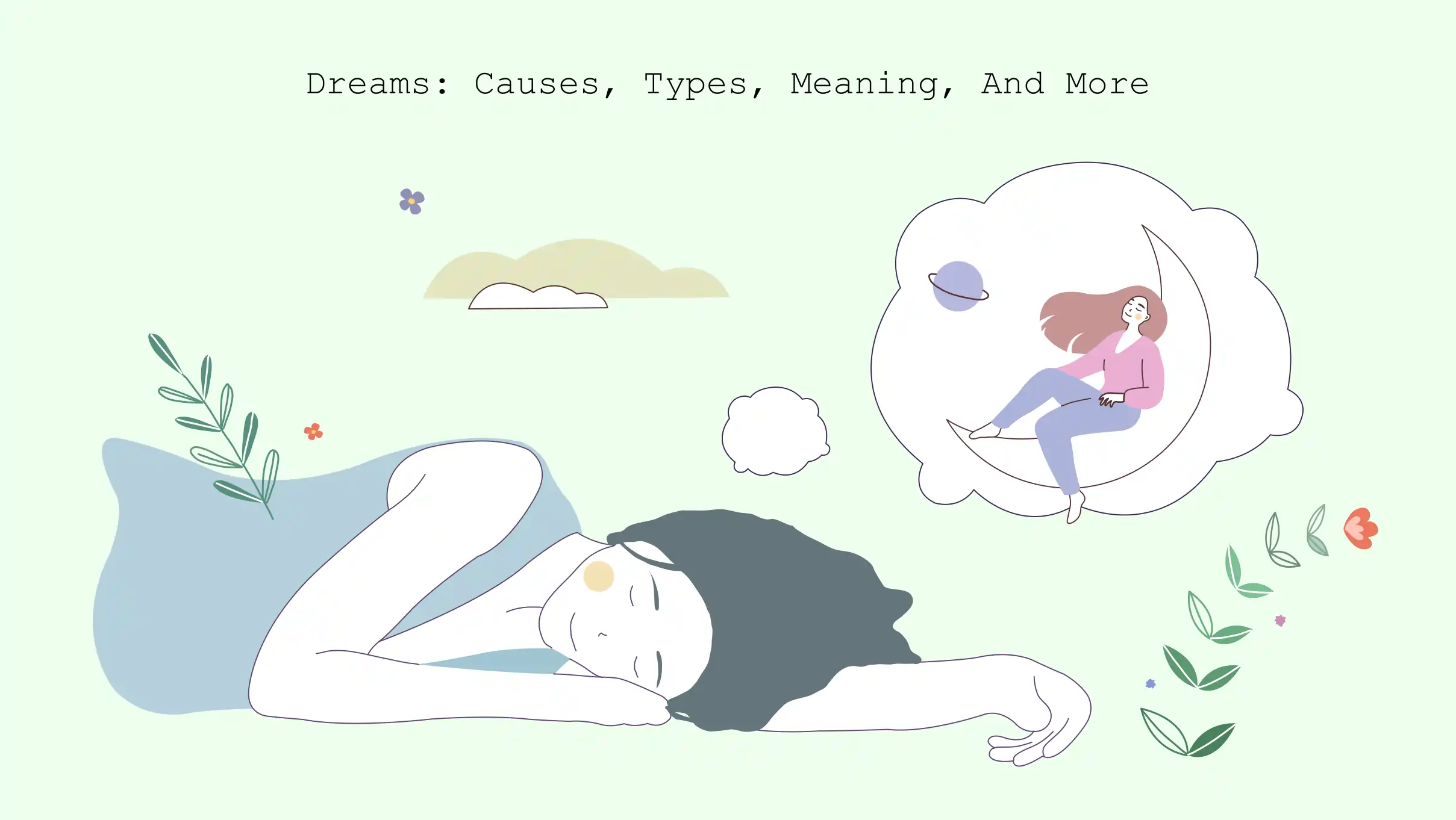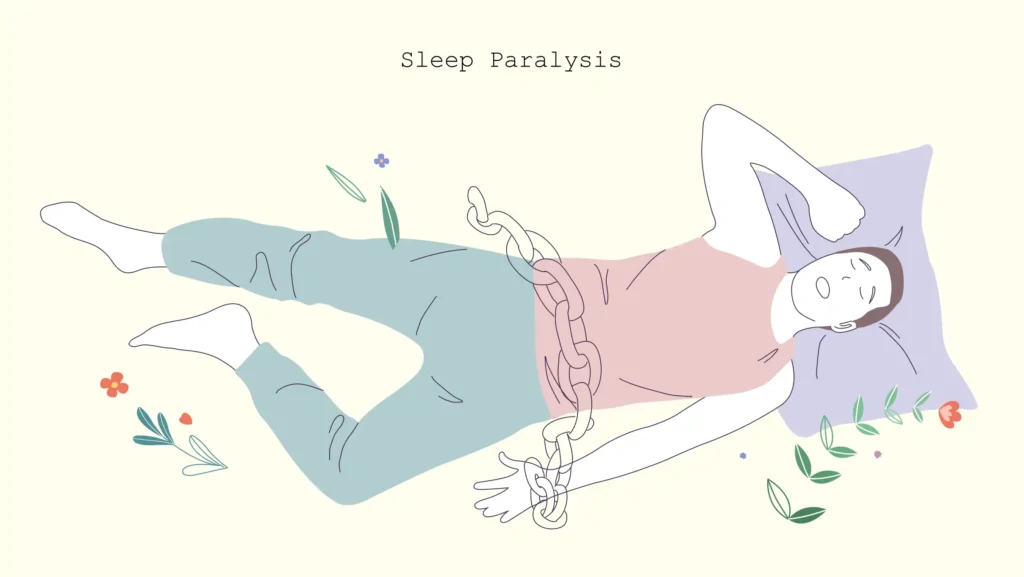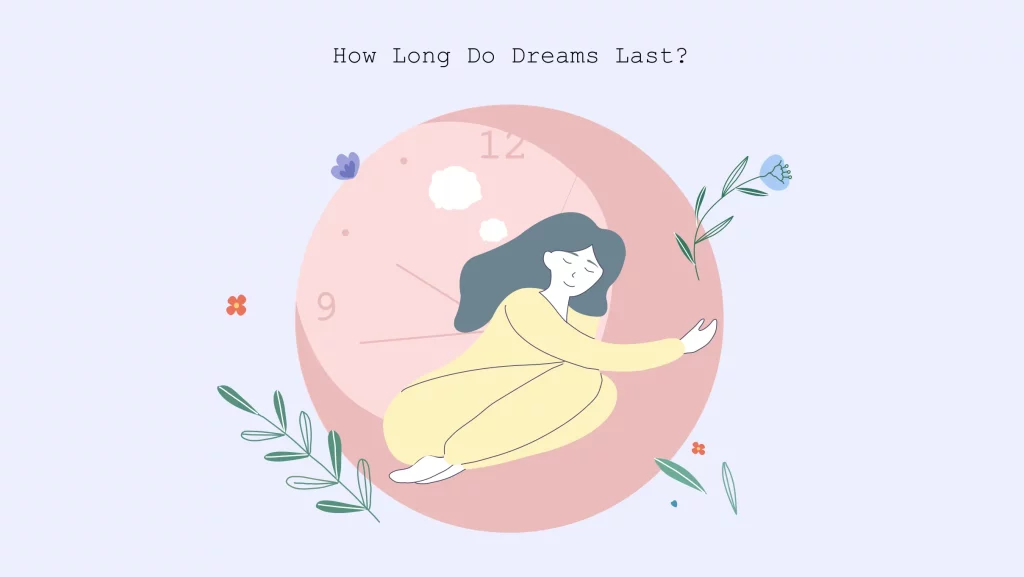Dreams: Causes, Types, Meaning, And More
Written by

Medical reviewed by


Dreaming is an enduring source of mystery for scientists and psychologists. It can be entertaining, fun, disturbing, frightening, and sometimes bizarre.
Besides that, dreams can bring about realizations about how a person feels and think, which can be beneficial for providing personal insight. However, do dreams really have any meaning behind their bizarreness?
Although there are no definitive answers, there are still several types of dreams, themes, and different factors that cause these dreams to occur. Read down further to explore the fascinating space of ‘dreaming.’
What are dreams
Dreams are images, ideas, emotions, and sensations that usually occur involuntarily in mind during certain stages of sleep. They may seem confusing or perfectly rational, entertaining, fun, romantic, disturbing, frightening, and sometimes bizarre.
Dreaming is still a mystery of human cognition, the neurophysiological correlates of dreaming are still unclear, and many questions remain unresolved because there are no proper ways to investigate the dreaming brain.
However, one thing that comes clear cut: Dreaming can happen anytime during sleep. But the sleeper has the most vivid dreams during a phase called REM (rapid eye movement) sleep.
Nightmares
Nightmares are dreams that are often dull, gloomy, and frightening and involve intense negative emotions. Research has indicated that a stressful event can cause more frequent nightmares, for example, exam stress, natural disasters, and the death of significant others.
And besides the stress of waking life, nightmares can occur because of conflict, fear, trauma, emotional problems, medication or drug use, and illness. However, if the nightmares are recurring and the sleeper, after an episode of a night terror, is awakened completely, is oriented immediately, and remembers the dream vividly, then the individual may have nightmare disorder.
Lucid Dreaming
Lucid dreams are the types of dreams where the dreamers become aware that they are dreaming. The dreamers become aware of their dreaming by noticing the bizarre events of the dream.
And contrary to some beliefs, lucid dreaming differs from REM sleep. However, lucid dreaming also constitutes a unique, hybrid state of sleep and wakefulness.
Furthermore, lucid dreamers can remember their dreams after waking. Fascinatingly, they can interpret the dream while dreaming and control it and its sequence of events. Not only can the lucid dreamer exert control over their actions, but they can also decide to interact with the environment, the characters, and the course of the dream.
Vivid Dreams
Vivid dreams are similar to lucid dreaming; however, unlike lucid dreams, the dreamers aren’t aware of the ‘dream.’ Instead the dreams feel more vivid and realistic. And though people can experience dreams in REM and NREM (Non-rapid eye movement), they are usually most vivid in REM sleep.
These vivid dreams can occur as a nightmare or can seem random. Anyhow, some people regard these vivid dreams as symbols that provide insight into mental health or if the subconscious may be trying to say something. However, there is no evidence to support this. But scientists do recognize that emotions can express themselves in dreams.
Why Do We Dream
There have been many theories about why we dream, but no one knows for sure. Are dreams just a part of the sleep cycle, or do they have any purposes?
Some research states that dreams do not serve any purpose; meanwhile, some say dreams have specific purposes regarding mental, emotional, and physical health. And thus, studies looked into the importance of dreams and speculated that dreaming serves the following functions:
- Dreams create a virtual reality that helps develop and maintain waking consciousness.
- Dreams are believed to be a biological defence mechanism as an efficient threat perception.
- Dreaming helps in the development of cognitive capabilities.
- Its functions are related to emotion and memory reprocessing, in which the brain consolidates learning.
- It is a unique state of consciousness that incorporates the experiences of the present, processes the past, and prepares for the future.
- It provides a ‘space’ where overwhelming, contradictory, or highly complex notions are brought together; this process serves the need for psychological balance and equilibrium.
When Do We Dream
Though dreams can happen in all stages of sleep, they are most likely to occur rather vividly during REM sleep. Following that, there are five stages of sleep in a sleep cycle: wake, 3 stages of NREM (N1, N2 and N3), and the REM sleep.
Wake stage
This phase depends on whether the eyes are open or closed. Then the individual starts feeling drowsy and closes their eyes.
Stage 01
This is the first stage of NREM. In this stage, the brain slows down first, and then the heartbeat, eye movements, and breathing slow down. Finally, the body relaxes, and muscles may twitch a little. This stage lasts for about 1 to 5 minutes before the sleeper moves into the next stage.
Stage 02
This is the NREM Stage 2. During this stage, the sleeper becomes less aware of their surroundings, their body temperature drops, and their eye movements stop. The breathing and heart rate also become more regular.
It lasts for about 25 minutes, during which memory consolidation takes place. It means that the brain gathers, processes, and filters new memories acquired the previous day.
Stage 03
This is the deepest stage of NREM sleep, which is also referred to as delta sleep. During NREM stage 3 sleep, the muscles are completely relaxed, blood pressure drops, and breathing slows down. And the sleeper progresses into the deepest sleep, and then the brain and body repair, restore, and reset for the coming day.
The brain also consolidates memories—for example, general knowledge, facts or statistics, personal experiences, and other things. So if the sleeper is woken up during this stage, they are likely to have ‘dreams’ that are memories..
REM
When the REM sleep cycle starts,the brain’s activity closely resembles its activity during waking hours; the body becomes relaxed and immobilized, breathing is faster and irregular, and the eyes move rapidly.
REM is also when the sleeper is in a deep sleep and when dreaming or nightmares happen. And similar to NREM 03, memory consolidation also occurs during REM sleep, and it is when emotions and emotional memories are processed and stored.
How long do dreams last
It’s hard to say for how long dreams last. But experts can provide an estimation about how long a person may spend dreaming.
According to the National Institutes of Health, a person spends about 2 hours dreaming each night mostly during REM sleep. REM sleep starts after 90 minutes of sleeping and lasts only a few minutes early in the night but gets longer as the person sleeps.
7 Common Dreams and their Meaning
The theory of dreaming proposes that the sleeping brain is a self-organizing system, combining irregular neuronal signals into a narrative during sleep called dreams. However, Freud regarded dreams as a royal road to the unconscious.
Freud also suggested that studying dreams’ apparent content could lighten the hidden and unconscious desires that lead to neurosis. However, interpreting dream symbols and ascribing meaning to them has become a source of both entertainment and self-reflection.
But what do they mean? Here are 7 common dreams and their Meaning.
Falling
Dreaming about falling is quite common. And though there is a popular myth that if the dreamer hits the ground in their dream, then they will die in real life, which simply is not true.
However, a study reported that dreaming about falling is popular and notorious for reoccurring. It is linked with negative emotions such as stress, sadness, or frustration.
Furthermore, the author of The Illustrated Dream Dictionary, Russell Grant, stated, “Dreaming of falling is very common, and it is a symbol of fear in real life, perhaps of failing at work or life.” He adds, “Falling often expresses a need to let yourself go more and enjoy life more.”
Being Naked in Public
The awkward and horror experience of being naked in public is one of the common dream themes. It’s where people dream of showing up at a public place like a school, an office, or the bus stop, dressed inappropriately /nude.
It, too, is said to be linked with negative emotions. And Penney Peirce, the author of Dream Dictionary for Dummies, suggests that dreaming of public nudity might indicate that the dreamer feels like a phoney or that they are afraid of revealing their imperfections and shortcomings.
Being Chased
Dreaming about getting chased or pursued by some stranger or something unknown is quite terrifying. And many people are subjected to these types of dreams.
Tony Crisp, the author of Dream Dictionary, suggests that being chased in a dream might indicate a desire to escape from one’s fears or desires. The key to understanding such a dream might depend partly on the identity of your pursuer. For example, if the chaser is of the opposite sex, then Crisp suggests this means you are afraid of love or haunted by a past relationship.
Dying/ death
Death is another common theme of dreaming that can be particularly disconcerting. And sometimes, the dreamer’s dream of the death of a loved one or even of dying themselves.
According to a study, dreams and visions of death are well documented throughout history and culture, along with the impact on the dying person and their loved ones having profound meaning. After a deep analysis of the dreams, six categories emerged: comforting presence, preparing to go, watching or engaging with the deceased, loved ones waiting, distressing experiences, and unfinished business were the themes.
Taking a Test
There are dreamers subjected to dreams about taking tests. And according to a British psychic, taking a test in the dreams might reveal an underlying fear of failure.
He writes in his book The Hidden Meaning of Dreams, “Examinations are stressful experiences in which you are made to face up to your shortcomings.” He also states, “To dream of failing a test, being late for one, or unprepared shows that the dreamer feels unprepared for the challenges of waking life.”
Teeth Falling
Dreaming about teeth falling out or rotting is one of the most common and usual dream themes. And a study aimed to explore whether tooth dreams would be related to a physiological stimulus and what this symbolizes.
According to the findings, teeth falling in dreams may relate to dental irritation during sleep and may be more common in people with depression. Or it has to do with deep personal loss, or just that the dreamer is worried about their attractiveness or appearance.
Soaring through the air/ flying
Flying dreams are pretty exciting, but they can be as terrifying, especially for those afraid of heights. So what does it mean? To answer simply, it doesn’t mean anything.
And according to a study report, some flying experiences in dreams are not accompanied by emotions. However, dreamers self-rate the emotional intensity of flying dreams to compare this dream type with other dreams. And it is stated that the intensity of the negative emotions is pretty high compared to the positive ones.
As flying dreams cannot be explained, many authors have speculated about the possible meaning of flying dreams. Like, according to Carl Jung, flying dreams symbolise overcoming life’s difficulties; other authors connect flying dreams with waking-life problems like impotence or avoidance. If flying dreams are ever associated with waking life, they often include negative emotions (mild anxiety or fear).
Why Are Dreams Hard to Remember
Researchers don’t know why dreams are easily forgotten since the only access to dreaming is dream reports, which are made later during waking life. And can be partial or modified by the waking consciousness.
One cannot measure cerebral activity during/on dreamful sleep versus dreamless sleep. Also, it can be harder to remember dreams during REM sleep since the body may shut down systems in the brain, where the dreamer only recalls dreams that happen just before waking up.
Tips for Dream Recall
A night of sound sleep and not waking up until the morning makes it harder to remember dreams. So, the following are some tips that may help with remembering the dreams:
Wake up without an alarm
Dreams may be easier to recall if the sleeper wakes up naturally. When waking up with an alarm, the brain’s focus first shifts to switching off the alarm.
Remind yourself to remember
Before going to sleep, remind yourself that you want to remember the dream. You are more likely to remember it if you decide to remember it.
Dream playback
Thinking about the dream right after waking up might make it easier to recall the dream.
Final Words
Dreams are fascinating and mysterious. However, in many cases, it is found that dreams reflect the events or concerns of waking life. Even though there has been ongoing research on the topic, scientists still don’t have all the answers to why we dream or the types of dreams we have. .
Also, behind the interpretation of the dreams, what do you think? Are the theories accurate enough?
FAQs
What is the true meaning of dreaming?
Dreams are extensions of reality, and because of the unconscious wants that limit these connections. A dream is the representation of suppressed desires or impulses.
How long is the average dream time?
Every night, the average person dreams for roughly two hours. Early in the night, REM sleep cycles typically last 10 minutes, and they gradually lengthen over the night to a maximum of around an hour.
Why do dreams feel so real?
We are able to hear, feel, and see in our dreams, similar to how we do when we are awake because the thalamus is active during REM sleep, sending the cerebral cortex images, sounds, and sensations.
people like this article
Written by

Medical reviewed by








